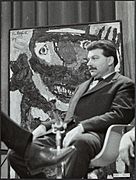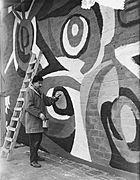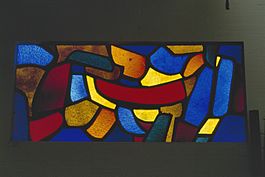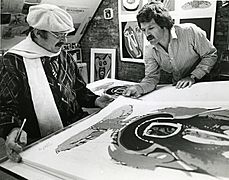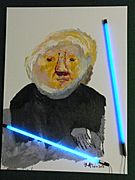Karel Appel facts for kids
Quick facts for kids
Karel Appel
|
|
|---|---|
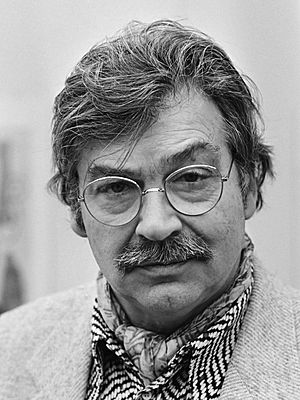
Karel Appel (1982)
|
|
| Born |
Christiaan Karel Appel
25 April 1921 Amsterdam, Netherlands
|
| Died | 3 May 2006 (aged 85) Zürich, Switzerland
|
| Education | Rijksakademie |
| Known for | Painting, drawing, sculpture, wall-painting |
| Movement | CoBrA |
Christiaan Karel Appel (born April 25, 1921 – died May 3, 2006) was a famous Dutch painter, sculptor, and poet. He started painting when he was just fourteen years old. Later, he studied art in Amsterdam in the 1940s.
Karel Appel was one of the people who started the special art group called CoBrA in 1948. He was also a very good sculptor. His artworks have been shown in famous places like the MoMA and other museums around the world.
Contents
Karel Appel's Early Life
Christiaan Karel Appel was born on April 25, 1921, in Amsterdam, the Netherlands. His family often called him 'Kik'. His father, Jan Appel, had a barbershop on the ground floor of their house. His mother, Johanna Chevalier, came from a French family called Huguenots. Karel had three brothers.
When he was fourteen, Appel made his first real painting on canvas. It was a still life of a fruit basket. For his fifteenth birthday, his rich uncle, Karel Chevalier, gave him a paint set and an easel. His uncle also liked to paint and taught young Karel some lessons.
Becoming a Professional Artist
From 1940 to 1943, Karel Appel studied at the Rijksakademie van Beeldende Kunsten in Amsterdam. This was during the time when Germany occupied the Netherlands. At the academy, he met two young painters, Corneille and Constant. They became very good friends.
Appel's parents did not want him to be an artist. Because of this, he left home. He also had to hide from the German police. They were trying to send young men to Germany to work in factories.
Appel had his first art show in Groningen in 1946. In 1947, he began making sculptures. He used old materials and painted them in bright colors like white, red, yellow, blue, and black.
The CoBrA Art Group
In 1948, Appel joined a new art group called CoBrA. The name CoBrA came from the first letters of the capital cities where the artists lived: Copenhagen, Brussels, and Amsterdam. Other Dutch artists like Corneille and Constant were also part of this group.
The CoBrA artists wanted to make art that was spontaneous and looked like it was made by children. Their new style of art was not very popular in the Netherlands at first. However, people in Denmark really liked it. Danish artists had already started making similar spontaneous art.
The CoBrA artists often worked together on paintings. For example, they painted the insides of houses. This helped them share their unique "childish" and spontaneous art style. In 1949, Appel painted a large picture called 'Questioning Children' in Amsterdam City Hall. Many people did not like it, and it was covered up for ten years.
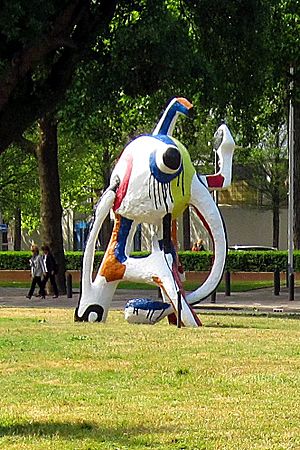
Global Recognition
Because of the controversy in the Netherlands, Appel moved to Paris in 1950. From there, he became famous around the world. He traveled to many countries, including Mexico, the United States, and Brazil. He also lived in New York City and Florence.
His first art show in America was in 1954. In America, he painted pictures of famous jazz musicians like Miles Davis. His painting Child and Beast II (1951) was shown in a big exhibition at the Museum of Modern Art. This show featured important European artists.
Appel was especially known for his large wall paintings. After 1990, he became much more popular in the Netherlands. He had several big shows in Amsterdam and Brussels. The CoBrA-museum in Amstelveen also showed many of his works. He became the most famous Dutch CoBrA artist.
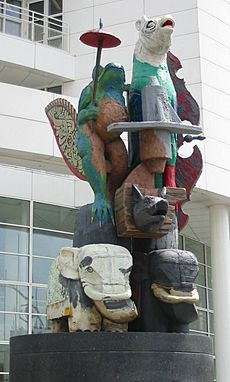
Appel's art has been shown in many galleries. These include the Anita Shapolsky Gallery in New York City and Galerie Lelong in Paris.
Later Life and Legacy
Karel Appel passed away on May 3, 2006, at his home in Zürich, Switzerland. He had a heart problem. He was buried in Paris, France, at the Père Lachaise Cemetery.
Before he died, Appel created the Karel Appel Foundation. This foundation helps to keep his artworks safe. It also helps people learn more about his art. The foundation is working on a complete list of all his paintings, drawings, and sculptures.
In 2002, some of Appel's artworks went missing while being sent to his foundation. They were found in 2012 in a warehouse in the UK and returned to the foundation. Today, the Karel Appel Foundation in Amsterdam manages his art and keeps an archive of his images.
Gallery
-
'Karel Appel, making a wall-painting in Rotterdam', 1955
Public Collections
Many public art collections around the world have artworks by Karel Appel. Some of these include:
- Museum de Fundatie, Zwolle, The Netherlands
- Aboa Vetus & Ars Nova, Turku, Finland
- Art Gallery of Hamilton, Ontario, Canada
- Rijksmuseum, The Netherlands
- The Phillips Collection, Washington D.C., US
- Collezione Peggy Guggenheim, Venice
- Didrichsen Art Museum, Helsinki
- Kunsthalle Bremen, Bremen
- Musée National d'Art Moderne, Centre Georges Pompidou, Paris
- Museum Ludwig, Cologne
- Museum Moderner Kunst, Vienna
- Neue Nationalgalerie, Berlin
- Rijksmuseum, Amsterdam
- San Francisco Museum of Modern Art, San Francisco
- Stanford University Museum of Art, Stanford
- Stedelijk Museum Amsterdam, Amsterdam
- Tate Modern, London
- The Museum of Modern Art, New York
- Gallery Delaive, Amsterdam, The Netherlands
- Frances Lehman Loeb Art Center, Poughkeepsie, NY, US
- Art Museum of Southeast Texas, Beaumont, Texas
- McClung Museum of Natural History and Culture, Knoxville, Tennessee
See also
 In Spanish: Karel Appel para niños
In Spanish: Karel Appel para niños


